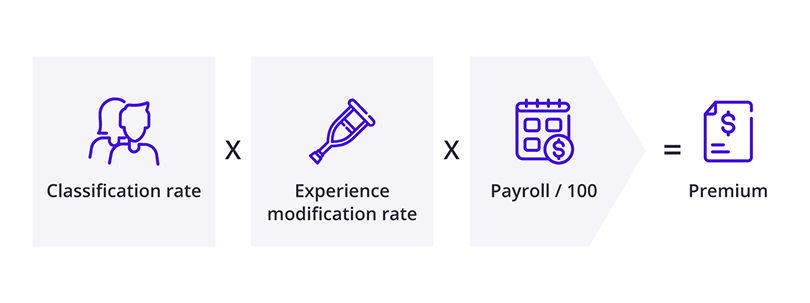

Minnesota workers' compensation insurance
Minnesota law requires every business to provide workers’ compensation insurance to its employees, with few exceptions. This policy pays for medical care and provides disability benefits for workers injured on the job.
Who needs workers’ comp insurance in Minnesota?
Every state has different requirements for workers’ compensation insurance. In Minnesota, all businesses with employees must provide workers’ compensation insurance. This requirement holds true even if a business only has one employee who works part-time.
Which employees are exempt from workers’ compensation insurance in Minnesota?
Although nearly all Minnesota employees must be covered by employer-provided workers’ compensation insurance, some worker categories are exempt. These include:
- Household employees in a private home who are making less than $1,000 over a three-month time span
- Farm workers who don’t exceed certain income thresholds, as well as the farmer / employer’s immediate family members (spouse, parent, or child)
- Casual employees not working in normal operations of the business or working just once or infrequently, not permanently or regularly

Do Minnesota business owners need to be covered by workers’ compensation?
Even if you're a sole proprietor, it's a good idea to carry workers' comp coverage. If you're injured on the job, there's a chance your health insurance provider could deny the claim, leaving you with expensive medical bills.
However, Minnesota business owners aren't required by law to carry workers’ compensation coverage, including:
- Sole proprietors and independent contractors
- Partners that own the business
- Corporate officers that own the business
- Members of an LLC
The following requirements apply to the prior exceptions:
For sole proprietors, immediate family members of the owner can also be excluded from the workers’ comp plan. Once a non-immediate family member is hired, you must provide workers’ comp coverage.
For partnerships, workers’ comp coverage isn’t necessary when every worker is a partner or an immediate family member of a partner.
For corporate officers, you must own 25% or more of a closely held corporation with 10 or fewer employees and less than 22,880 hours of payroll in the prior year. A spouse, parent, or child of a corporate officer is exempt. However, employees who are more distantly related to an officer may file a written exclusion request.
For LLC members, the requirements are similar to those for corporate officers of closely held corporations.
If you are one of the above exempt individuals, you can still elect to participate in your firm’s workers’ compensation plan. Having full insurance protection is a wise financial decision, especially if you work in a risky industry.
Minnesota law requires every business to provide workers’ compensation insurance to its employees, with few exceptions.
What does workers' comp cover for Minnesota businesses?
Here are several examples of how workers' compensation insurance coverage helps pay expenses for injured workers:
- A personal care aide develops a back injury from transferring and lifting patients, and can no longer perform their duties. In this instance, workers' compensation would also provide retraining benefits so they could learn the skills to take on a new job.
- A project manager trips on a cord while visiting a jobsite and breaks their wrist. Workers' comp covers the cost of the ER visit, surgery, medications, and then two months of physical therapy to help them recover.
- A fast food worker burns themselves while preparing an order for a customer. Workers' comp covers their medical treatment and pain medication.
- A general contractor injures their hand while building a home addition. Workers' comp covers their healthcare provider appointment and pain medication, and provides disability benefits to replace part of the wages they miss while they are recovering.
What does workers' compensation insurance not cover?
Additionally, here's what your workers' comp policy won't cover:
- Injuries caused by intoxication, drugs, or company policy violations
- Injuries claimed after a firing or layoff
- Wages for a replacement worker
- Occupational Safety and Health Administration (OSHA) fines
How much does workers' compensation insurance cost in Minnesota?

The average cost of workers’ compensation in Minnesota is $51 per month.
Your workers' comp premium is calculated based on a few factors, including:
- Payroll
- Location, such as Minneapolis, Saint Paul, or Rochester
- Number of employees
- Industry and risk factors
- Coverage limits and exclusions
- Claims history
How is workers' comp purchased in Minnesota?
Business owners in Minnesota have a few choices when it comes to buying a workers' compensation policy:
- Private insurance companies. You could contact each workers' compensation insurance carrier independently to compare their products and rates, but that's where agents and brokers like Insureon come in. As the nation's leading digital insurance agency, Insureon partners with 40+ top-rated insurance carriers to deliver the right coverage for your business. Fill out an easy online application to get started.
- Self-insurance. Minnesota employers also have the ability to self-insure their workers’ compensation claims. This means they’ll pay for their own workers’ comp medical and rehabilitation costs rather than submit them to their workers’ comp insurer.
- Purchase coverage from the state risk market. If a business owner is unable to qualify for a workers’ comp policy, they can buy it from the state’s assigned risk residual market, the Minnesota Workers’ Compensation Assigned Risk Plan. This is the insurance plan of last resort for high-risk Minnesota employers that can’t find standard coverage due to their extensive number of past workers’ comp claims.
Verified workers' compensation insurance reviews
Insurance providers use a specific formula for calculating workers' comp premiums: Classification rate x Experience modification rate x (Annual payroll / $100).

Here's a breakdown of this equation:
- The classification rate reflects your employees' risk. Each worker has a classification code for the type of work they do. Insurers look up those codes in a database to find the associated rate, which is lower for office workers and higher for carpenters, tree trimmers, and others with a higher rate of injuries. Unlike most other states that rely on the National Council on Compensation Insurance (NCCI) database, Minnesota utilizes their own independent workers' compensation system.
- The experience modification rate (EMR) reflects your business's risk. The average experience modification rate is 1.0, which means a business is similar in risk to others in its profession. Higher EMRs reflect higher risks, such as a history of claims. The EMR only comes into play for annual workers' comp premiums of at least $5,000, so it's not a factor for many small business owners.
- The insurer multiplies these numbers with your payroll divided by 100 to come up with your workers' compensation rate. Workers' compensation audits are typically done each year to ensure your business pays the right premium for this coverage.
How can Minnesota business owners save money on workers' comp?
To save money on workers' comp insurance, it's important to make sure you classify your employees correctly. Employees with desk jobs or other jobs with a low risk of injury cost less to insure. This also helps you avoid misclassification fines.
In some cases, small business owners can choose to buy pay-as-you-go workers' compensation. This type of workers' comp policy has a low upfront premium, and lets you make payments based on your actual payroll instead of an estimated payroll. It's useful for businesses that hire seasonal help or have fluctuating numbers of employees.
A ghost policy is a cheap option in some states, including Minnesota. A ghost policy is a workers' comp policy in name only. It provides no protection or medical benefits, but can fulfill contractual requirements for a workers' comp certificate at a reduced price.
Finally, a documented safety program can help lower workers' comp costs. A safer workplace means fewer accidents, which helps keep your premium low.
How does workers' compensation work in Minnesota?
Workers' compensation covers the cost of medical treatment and provides wage-loss benefits for employees who are injured on the job or who develop an occupational disease.
Most policies include employer's liability insurance, which helps cover legal expenses if an employee blames their employer for an injury. However, the exclusive remedy provision in most workers' comp policies prohibits an employee from suing their employer if they accept workers' comp benefits.
Workers' compensation benefits for injured workers in Minnesota include:
- Temporary total disability benefits (TTD)
- Temporary partial disability benefits (TPD)
- Permanent total disability benefits (PTD)
- Permanent partial disability benefits (PPD)
- Medical benefits (surgery, prescriptions, physical therapy, and other medical expenses)
- Vocational rehabilitation services
- Death benefits for fatal injuries
For details and general information, visit the Minnesota Department of Labor and Industry (DLI) page on workers' compensation.
What are the penalties for not having workers’ comp insurance in Minnesota?
If you fail to meet Minnesota workers’ compensation system insurance requirements, you may be ordered to not hire employees until you secure insurance.
You also may be ordered to pay a fine of up to $1,000 per employee / per week in which you failed to provide workers’ compensation insurance.
If one of your employees suffers a job-related injury or illness during the time you lacked insurance, you may be ordered to pay the person’s workers’ comp benefits back to the state, along with a penalty of 65% of those benefits.
Other penalties may apply, as well.
Workers’ compensation death benefits in Minnesota
If an employee dies as a result of a work-related injury or illness, certain family members may be eligible for death benefits. These include weekly payments to cover part of the deceased employee’s income, along with funeral and burial costs.
Eligible family members include:
- The worker’s spouse (unless that person was voluntarily living independently of the deceased worker at the time of the incident)
- A child under age 18 (or 25 if going to school full time)
- A disabled adult child who can’t support him or herself
Other eligible dependents include those the deceased worker supported financially: parents, parents-in-law, grandparents, or brothers and sisters.
The deceased worker’s family will receive death benefits equal to no more than 67% of the deceased employee’s average weekly wage, an amount that can’t exceed the maximum set by law each year.
Minnesota state law also provides for annual cost of living adjustments to workers’ comp benefits, starting on the third anniversary.
Minnesota workers' compensation law for settlements
A workers’ compensation settlement is an agreement between the involved parties that will resolve a workers’ compensation claim. This benefits both the employee and the employer. A settlement in a Minnesota workers’ compensation claim falls into two categories:
To-date settlements resolve the case up to the settlement date, but leave open the possibility of further action after the settlement date.
Full and final settlements close the case completely, but may leave open the right to continue submitting medical claims.
According to Minnesota statutes, all settlements are subject to the approval of a workers’ compensation judge at the Minn. Office of Administrative Hearings.
Workers’ compensation statute of limitations in Minnesota
The statute of limitations for workers’ comp claims in Minnesota is three years from the date of injury or illness as long as the employer filed a First Report of Injury with the Minnesota Department of Labor and Industry.
If the employer didn’t file this report, the statute of limitations is six years from the incident date.
Get free workers’ comp quotes with Insureon
If you are ready to buy a workers' compensation policy, start a free application with Insureon to compare quotes from top-rated insurance carriers. A licensed insurance agent will help answer your questions and explain your coverage options. Once you find the right policy, you can usually begin coverage and get your certificate of insurance in less than 24 hours.

Want free expert advice right in your inbox?
By entering your email address and subscribing, you agree to our Terms of Use and Privacy Policy